Mstyslav Chernov
Mstyslav Chernov | |
|---|---|
Мстислав Андрійович Чернов | |
 Mstyslav Chernov, London, 2017 | |
| Born | 1985 (age 36–37)[1][2] |
| Nationality | Ukraine |
| Occupation |
|
| Employer | The Associated Press |
| Website | www |
Mstyslav Chernov (Ukrainian: Мстислав Андрійович Чернов; born 1985) is a Ukrainian photographer, photojournalist, filmmaker, war correspondent and novelist known for his coverage of Ukrainian revolution, War in Donbass, including the downing of flight MH17, Syrian Civil War, Battle of Mosul in Iraq as well as for his diverse photography exhibitions. Chernov is an Associated Press journalist and the President of the Ukrainian Association of Professional Photographers (UAPF). Chernov's materials have been published and aired by multiple news outlets worldwide, including CNN, BBC, The New York Times, Washington Post, and others. He has both won and been a finalist for prestigious awards, including the Livingston Award, Rory Peck Award and various Royal Television Society awards. Chernov has been wounded several times while working in conflict zones.
Career in photography and journalism[]
Fine-art and documentary photography: 2005—2013[]
Chernov started his career in photography in 2005, working for a local Kharkiv news agency MediaPort.[3][4] He gained notoriety in 2008 when he received the 1st prize at a local photography exhibition "Kharkiv through the eyes of its inhabitants".[5] In the same year, he had his first personal photography exhibition "Musica per somnia," conceived and organized with assistance of Yuriy Yanko, the Director of Kharkiv Philharmonic Society, who was impressed by Chernov's photographs of Sayaka Shoji, a Japanese violinist, then performing with Kharkiv Philarmonics.[4][5] In 2009, Chernov won another first place award in local photo expo "Almost disappearing Kharkiv", covering crumbling examples of the city's older architecture.[6]
Starting in 2008, Chernov worked with Chernobyl Children International, the Novick Cardiac Alliance, photographing cardiac surgeries.[7] Chernov's transition to documentary photography continued. In 2012 he lived in Cambodia, focusing on local health care and cultural projects.[8]
Meanwhile, by 2013, Chernov's work gained national recognition. His 2013 photographs landed him the first place in the Ukrainian contest "Photographer of the Year" in nomination documentary photography.[9] In the same year, Chernov was a winner of the Pentax Awards Ukraine 2013[10] and Best Press Photographer, Ukraine, nomination "portrait".[11] He photographed in over forty countries and had another personal exhibition, Rainy Season, featuring images of the Far East.[12][13]
In 2013, Chernov became the President of the Ukrainian Association of Professional Photographers (UAPF).[1][14] Chernov's installation art project Peeking in Windows – placing enlarged old photographs into windows of abandoned buildings – gained the attention of the national press and was repeated in subsequent years.[14][15][16] In 2013, Chernov was invited to participate in Unframe, an international project around documentary photography.[17]
- Samples of Chernov's 2005—2013 photographs
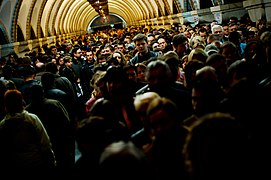
Zoloti Vorota subway station, Kyiv, 2007

Street barber, Ho Chi Minh City, Vietnam, 2009

Santa Maria di Loreto, Rome, Italy, 2009
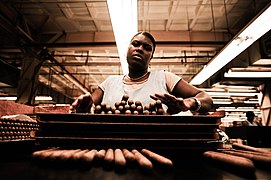
Cigar Factory, Dominican Republic, 2011

Sri Lankan fisherman, 2011
Journalism[]
In the summer of 2013, while photographing in Istanbul, Turkey, Chernov found himself in the middle of Gezi Park protests. The images of night violence impressed Chernov and triggered a shift from fine-art photography and documentary photography to conflict and war reporting.[18]
- Chernov's photographs of Gezi Park Protests, Istambul, 2013

June 3, 2013

June 5, 2013
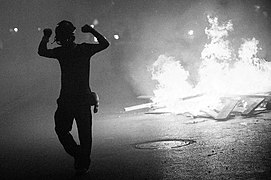
June 15, 2013

June 15, 2013

June 15, 2013
Euromaidan[]
In late 2013, Ukraine's capital Kyiv became embroiled in mass protests – "Euromaidan" which culminated in bloodshed, Ukrainian Revolution of 2014, and the ousting of the Ukrainian president Viktor Yanukovich. Chernov photographed the action as a MediaPort and Unframe correspondent. As violence intensified, he was attacked and wounded several times. In early December 2013, pro-Yanukovich police targeted and attacked members of the press, injuring Chernov's hand with a baton, tearing up his press credentials, and destroying his photography equipment.[19] In January 2014, ignoring Chernov's insignia that identified him as a member of the press, a pro-Yanukovich policeman deliberately threw a stun grenade into Chernov, injuring his legs and eye with shrapnel.[20][21]
The events in Kyiv attracted considerable international attention. Many international reporters flocked to cover the Ukrainian Revolution which later transitioned into the annexation of Crimea and War in Donbass. Chernov provided the international reporters with local assistance, also starting as a translator and a stringer for The Associated Press.[18][22] Chernov's background in photography and his partnership with other reporters allowed him to polish his video filming skills and become a regular freelancer for Associated Press in May 2014.[22]
- Chernov's photographs of Euromaidan, 2013—2014

Protesters, November 30, 2013

Berkut man pointing gut at protesters, January 19, 2014

January 22, 2014

February 18, 2014

Bodies of protesters, February 20, 2014
Career with Associated Press[]
By July 2014, Chernov already worked as an independent multi-format (text, photo, and video) journalist for The Associated Press.[22] Russian military intervention to Donbass had created another conflict zone in Ukraine, and Chernov covered War in Donbass in 2014, becoming one of very few journalists who reported the conflict from both sides.[23][24][25]
On his third day working as an independent AP journalist, Malaysia Airlines Flight 17 was shot down in the area, and Chernov provided first images of the incident. Chernov's reporting played an essential role in The Associated Press' coverage of the event.[22] For his coverage of the event, Chernov was awarded "Young Talent of the Year" Award by Royal Television Society.[22]
In subsequent years as an AP journalist and war correspondent, Chernov covered the war in Syria and the Battle of Mosul in Iraq[18] as well as the European migrant crisis in Greece, Macedonia, Slovenia, Croatia, Hungary, Austria, and Germany.[17] In 2017, in Mosul, a sniper bullet pierced through Chernov's camera and stuck in his ballistic vest.[24] Chernov's Iraqi videos were finalist entries for Rory Peck Award in 2017[26][27] and for Royal Television Society awards in 2017 and 2018.[28][29]
Chernov's reports were published worldwide, including being picked up by The Independent,[30] The Seattle Times,[31] Military Times,[32] Navy Times,[33] Washington Examiner.[34] Chernov's photographs were also published in the New York Times, Washington Post, Wall Street Journal, Forbes, Guardian, Daily Telegraph, Dailymail, Le Monde, Deutsche Welle, Die Zeit, and others, and his videos were aired on BBC, EuroNews, CNN, Fox News, Sky News, Al Jazeera, and others.[17] In 2016, a Royal Television Society judge commented that "given the range, volume, and global distribution of [Chernov's] footage, there may have been days last year when we watched [Chernov's reporting] all day."[35]
- Samples of Chernov's documentary photographs, 2015—2016

Mourning of fighters, Donetsk, Ukraine, June 2015
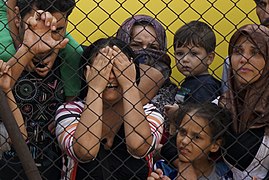
Syrian refugees in Hungary, September 2015
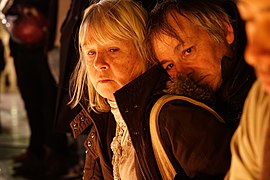
The aftermath of Paris Terrorist Attacks, November 2015

Mosul, Iraq, November 2016
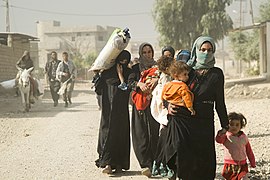
Mosul, Iraq, November 2016
Chernov's style[]
Outside observers note Chernov's deep compassion to humanity that makes his imagery influential. They also note the vast spectrum of his creative work and his "exceptional eye for detail."[36]
A Ukrainian photographer and a photography exhibition curator in Kharkiv, Vladimir Ogloblin, commented on Chernov's work: "Mstyslav has exceptionally deep vision [sic] it's obvious that he feels for the people on his photographs. Mstyslav has a good intuition, a rare gift, how to convey in photographs what he sees."[37]
The Director of the European news section of The Associated Press, Caro Kriel, said: "Through his involvement in some critical stories, Chernov has quickly proved himself to be a rare, multiformat journalist with an uncanny ability to develop a story in the most difficult conditions. He is a natural visual storyteller and his signature trait – compassion for humanity that suffuses almost every image – has ensured that his work has had an immediate impact."[22]
A judge of Royal Television Society Awards commented that "[Chernov] has an exceptional eye for detail and a full range of shots across his portfolio, capturing emotion and conveying the fear and sometimes panic that was at the heart of so many news events last year."[35]
Chernov himself believes that war should not be glamorized but pictured as is. Commenting on his own work, Chernov noted that he doesn't necessarily enjoys war journalism, but feels that he's at the right place, albeit his work might transition at some point to a different kind of photography, for example, to working for National Geographic.[24]
Chernov prefers to work "light," carrying simpler, smaller equipment, that could always be on him and ready to shoot at all times. He works with small cameras and usually doesn't use a tripod.[27]
Writing[]
In January 2020, Chernov presented his psychological novel Dreamtime (Ukrainian: Часи сновидінь), a 500-page fiction conceived and written over an 8-year period.[38][39] Alluding to aboriginal Dreamtime, the novel examines societies' collective experiences ("dreams") with war and conflict and is loosely based on real events that Chernov witnessed during the War in Donbass, the Migration crisis in Europe and others.[40][39] It features four intertwined plot lines that span across vast geography from Eastern Ukraine to Southern Europe, then to Southeast Asia, yet united by a common theme of internal conflict resolution.[38][39] The novel was launched in Kyiv as a focal point of a video art exhibition devoted to the role of media in creating public collective experiences.[40][41] The novel was credited for its creative literary application of dreams to showcase protagonists' psyches and for its "serious" and "masterly prose."[40][42]
Awards[]
| External video | |
|---|---|
| Year | Award | Category | Result | Ref |
|---|---|---|---|---|
| 2020 | Royal Television Society Award | Camera Operator of the Year | Nominated | [43][44] |
| 2019 | APME: Powerful Stories | Use of video | 1 | [45] |
| 2019 | Livingston Award | International Reporting | Finalist | [46] |
| 2018 | Royal Television Society Award | Camera Operator of the Year | Nominated | [28] |
| 2017 | Royal Television Society Award | Camera Operator of the Year | Nominated | [29] |
| 2017 | Rory Peck Award | Finalist | [26][27] | |
| 2016 | Royal Television Society Award | Camera Operator of the Year | Won | [35] |
| 2015 | Ukrainian photographer of the year (2014) | Reportage | 1 | [23] |
| 2015 | Royal Television Society Award | Young Talent of the Year | Won | [47] |
| 2014 | Ukrainian photographer of the year (2013) | Reportage | 1 | [9][48] |
| 2014 | Humanity Photo Award (HPA) (2013) | Finalist | [17] | |
| 2013 | Pentax Awards, Ukraine | Won | [10] | |
| 2013 | PRESSzvanie Awards, Ukraine | Portrait | Won | [11][49][50] |
| 2013 | International FIPP FREMANTLE Portrait Photography Contest, Australia | Portrait | Finalist | [17] |
| 2013 | Ukrainian photographer of the year (2012) | Documentary photography | 2 | [51] |
| 2013 | Panasonic Photo Contest, Ukraine | Won | [17] | |
| 2009 | Almost disappearing Kharkiv, Kharkiv, Ukraine | 1 | [6] | |
| 2008 | Kharkiv through the eyes of its inhabitants, Kharkiv, Ukraine | 1 | [5] |
Exhibitions[]
| Year | Name | Location | Ref |
|---|---|---|---|
| 2020 | Production of Dreams, or What the Modern Media Machine Offers | Kyiv, Ukraine (with Igor Chekachkov) | [52][53] |
| 2019 | The Ukrainian Revolution | Khmelnytskyi, Ukraine | [2] |
| 2017 | Ukraine on Fire | Düsseldorf | [54] |
| 2015 | Maidan – Valor, Will and Pain | Kharkiv, Ukraine | [55] |
| 2015 | I'm a Volunteer at Heart | Sumy, Ukraine | [56] |
| 2014 | Red, International Red Cross | Kyiv, Ukraine | [17] |
| 2013 | Euromaidan: freedom territory | Riga, Latvia | [17] |
| 2013 | Rainy Season | Kharkiv, Ukraine | [3][12][13] |
| 2008 | Musica per Somnia | Kyiv, Ukraine | [4][5] |
See also[]
- The Associated Press
- Euromaidan
References[]
- ^ a b c UAPF 2019.
- ^ a b Museum Space, February 19, 2019.
- ^ a b Kharkiv City Council, March 14, 2013.
- ^ a b c Kharkov city portal, March 21, 2008.
- ^ a b c d Kolesnik 2008.
- ^ a b Simonenko 2008.
- ^ Unframe, March 12, 2013.
- ^ Unframe, November 11, 2013.
- ^ a b Foto.ua, March 26, 2014.
- ^ a b Foto.ua, December 27, 2013.
- ^ a b Ukrainian News, April 23, 2013.
- ^ a b Center for Culture and Art 2013.
- ^ a b 057.ua 2013.
- ^ a b Gorchins'ka 2013.
- ^ Zharenov 2015.
- ^ Zhuravleva 2015.
- ^ a b c d e f g h Unframe, 2019.
- ^ a b c Gordіenko 2018.
- ^ Kornienko 2013.
- ^ Evening Kharkiv, January 27, 2014.
- ^ MediaPort, January 22, 2014.
- ^ a b c d e f Imregi 2015.
- ^ a b Foto.ua, July 2, 2015.
- ^ a b c Meshherjakova 2018.
- ^ The VASA Project, June 2, 2014.
- ^ a b BBC 2017.
- ^ a b c Romanek 2017.
- ^ a b Television, February 28, 2018.
- ^ a b Television, March 1, 2017.
- ^ The Independent 2014.
- ^ The Seattle Times 2019.
- ^ Military Times 2017.
- ^ Washington Examiner 2014.
- ^ a b c Television, February 17, 2016.
- ^ Business Insider, February 18, 2016.
- ^ Dikan' 2013.
- ^ a b Landesman 2020.
- ^ a b c Gordon Boulevard 2020.
- ^ a b c Nikitenko 2020.
- ^ Pugach 2020.
- ^ Ukrainian literary newspaper 2020.
- ^ Television 2020.
- ^ MediaSapiens 2020.
- ^ Sellers-Earl 2019.
- ^ Riley 2019.
- ^ Television, February 18, 2015.
- ^ Photonews Post 2014.
- ^ Foto.ua, April 29, 2013.
- ^ Unframe, May 13, 2013.
- ^ AdMe.ua, March 1, 2013.
- ^ Kyiv Post 2020.
- ^ Vogue Ukraine 2020.
- ^ Kin-Top 2017.
- ^ Kharkiv Regional Administration, February 18, 2015.
- ^ Kas'janenko 2015.
Literature cited[]
- Sellers-Earl, Laura (June 19, 2019), Koetting, Tom (ed.), "2019 APME awards honor AP journalists for powerful stories", APME:Associated Press Media Editors, New York City: APME Foundation, retrieved December 6, 2019
- Zharenov, Jaroslav (July 29, 2015), Aleksandr, Shvec (ed.), "V zabroshennom zdanii na Jaroslavovom Valu pojavilas' vystavka starinnyh fotografij" В заброшенном здании на Ярославовом Валу появилась выставка старинных фотографий [An exhibition of old photographs appeared in an abandoned building on Yaroslavovo Val], Fakty i kommentarii Факты и комментарии [Facts and comments] (in Russian), Kyiv: Bothain Consulting (136 (4354)), ISSN 1606-5557, OCLC 1127159341, retrieved December 6, 2019
- Kuz'mіn, Dmitro, ed. (April 23, 2013), "PRESSzvanie: nazvanі іmena krashhih fotoreporterіv" PRESSзвание: названі імена кращих фоторепортерів [PRESScalling: The names of the best photojournalists are named], Ukraїns'kі Novini Українські Новини [Ukrainian news] (in Ukrainian), Ukrainian News Agency, retrieved December 6, 2019
- Dikan', Filipp (March 15, 2013), Fedorkova, Tat'jana (ed.), ""Sezon dozhdej" – fotovystavka bez avtora" "Сезон дождей" – фотовыставка без автора ["Rainy Season" – photo exhibition without an author], MediaPort (in Russian), Kharkiv: MediaPort, retrieved December 6, 2019
- Kornienko, Mihail (December 4, 2013), Efimenko, Nikolaj (ed.), "K chemu spory? Ukraina uzhe v Evrope" К чему споры? Украина уже в Европе [Why argue? Ukraine is already in Europe], From-UA: Novosti Ukrainy From-UA: Новости Украины [From-UA: Ukraine News] (in Ukrainian), Kyiv: From-UA, retrieved December 6, 2019
- Kostenko, Tatyana, ed. (January 27, 2014), "Na ulice Grushevskogo v Kieve zhurnalisty provodjat akciju protesta" На улице Грушевского в Киеве журналисты проводят акцию протеста [On the Grushevsky street in Kiev, journalists hold a protest], Vecherniy Kharkov Вечерний Харьков [Evening Kharkov] (in Russian), Kharkiv: ТОВ "Редакція газети 'Вечірній Харків'", OCLC 762014020, retrieved December 6, 2019
- Imregi, Laura (February 19, 2015), Buzbee, Sally (ed.), "AP's Mstyslav Chernov named young talent of the year at RTS Television Journalism Awards", Associated Press, New York City: The Associated Press, OCLC 464378787, retrieved December 6, 2019
- Riley, Melissa (May 2, 2019), Holdship, Deborah (ed.), "University of Michigan announces 2019 Livingston Award finalists", University of Michigan News, Ann Arbor: University of Michigan, retrieved December 6, 2019
- Gordіenko, Tetjana (May 7, 2018), Ligachova, Natalіja (ed.), "Voennij reporter Associated Press: Bezpeka — ce zavzhdi kompromіs, іz soboju ta z redaktorom u tomu chislі" Воєнний репортер Associated Press: Безпека — це завжди компроміс, із собою та з редактором у тому числі [Associated Press War Reporter: Security is always a compromise, myself and the editor including], MediaSapiens (in Ukrainian), Kyiv: Детектор медіа, retrieved December 6, 2019
- Fedorkova, Tat'jana, ed. (January 22, 2014), "Prjamoe popadanie" Прямое попадание [Direct hit], MediaPort (in Russian), Kharkiv: MediaPort, retrieved December 6, 2019
- Clarke, Steve, ed. (February 18, 2015), "RTS Television Journalism Awards 2015: The Winners", Television: Royal Television Society, London: Royal Television Society, ISSN 0308-454X, LCCN 85647402, retrieved December 6, 2019
- Clarke, Steve, ed. (March 1, 2017), "Television Journalism Awards 2017", Television: Royal Television Society, London: Royal Television Society, ISSN 0308-454X, LCCN 85647402, retrieved December 6, 2019
- Clarke, Steve, ed. (February 28, 2018), "Television Journalism Awards 2018 sponsored by Guestbooker", Television: Royal Television Society, London: Royal Television Society, ISSN 0308-454X, LCCN 85647402, retrieved December 6, 2019
- Clarke, Steve, ed. (February 17, 2016), "Television Journalism Awards 2016", Television: Royal Television Society, London: Royal Television Society, ISSN 0308-454X, LCCN 85647402, retrieved December 6, 2019
- "Chernov Mstyslav", ukrainianphotographers.com (in Ukrainian), Kyiv: UAPF, 2019, retrieved December 7, 2019
- Meshherjakova, Ekaterina (May 20, 2018), Gordejchik, Evgenij (ed.), ""Esli bezopasnosti net, patriotizm nikogo ne volnuet". Voennyj fotograf — o rabote v Sirii, Irake i na Donbasse" "Если безопасности нет, патриотизм никого не волнует". Военный фотограф — о работе в Сирии, Ираке и на Донбассе ["If there is no security, patriotism does not bother anyone. A war photographer — about work in Syria, Iraq, and the Donbass], Focus ФОКУС [Focus] (in Russian), Kyiv: Ukrainian Media Holding, retrieved December 6, 2019
- Gorchins'ka, Oleksandra (December 27, 2013), Ruban, Volodimir (ed.), "U Kievі zapustili fotoproekt "Zazirajuchi u vіkna"" У Києві запустили фотопроект "Зазираючи у вікна" [Kyiv begins A photography project "Peeking in Windows" launched in Kiev], Gazeta.ua (in Ukrainian), Kyiv: Нова інформація, retrieved December 6, 2019
- Gasidzhak, Lesja, ed. (February 19, 2019), "Vistavka fotografії Mstislava Chernova "Ukraїns'ka revoljucіja" u Hmel'nic'komu muzeї-studії fotomistectva" Виставка фотографії Мстислава Чернова "Українська революція" у Хмельницькому музеї-студії фотомистецтва [Mstislav Chernov's photo exhibition "The Ukrainian Revolution" at Khmelnytsky Museum of Art], Muzejnij prostіr Музейний простір [Museum Space] (in Ukrainian), Kyiv: Український центр розвитку музейної справи, retrieved December 6, 2019
- "Ukraine In Flammen" [Ukraine in flames], Kin-Top (in German), Dusseldorf: Kin-Top Förderungszentrum e.V., 2017, retrieved December 6, 2019
- "U centrі kul'turi і mistectva vіdkrilas' vistavka fotografії "Majdan – muzhnіst', volja ta bіl'"" У центрі культури і мистецтва відкрилась виставка фотографії "Майдан – мужність, воля та біль" [The exhibition of photography "Maidan – valor, will, and pain" opens at the Center of Art and Culture], Ofіcіjnij veb-sajt Harkіvs'ka oblasna derzhavna admіnіstracіja Офіційний веб-сайт Харківська обласна державна адміністрація [Official web site of Kharkiv Regional State Administration] (in Ukrainian), Kharkiv: uk:Харківська обласна державна адміністрація, February 18, 2015, retrieved December 6, 2019
- "V Har'kove projdet fotovystavka Mstislava Chernova, posvjashhennaja jugo-vostochnym aziatskim stranam" В Харькове пройдет фотовыставка Мстислава Чернова, посвященная юго-восточным азиатским странам [Kharkiv will host a photo exhibition of Mstislav Chernov, dedicated to the southeast Asian countries], Oficial'nyj sajt Har'kovskogo gorodskogo soveta, gorodskogo golovy, ispolnitel'nogo komiteta Официальный сайт Харьковского городского совета, городского головы, исполнительного комитета [Official site of Kharkiv city council, mayor, executive committee] (in Russian), Kharkiv: Харківська міська рада, March 14, 2013, retrieved December 6, 2019
- Kolesnik, Valerija (March 19, 2008), Fedorkova, Tat'jana (ed.), "Kakie ljudi snjatsja Muzyke? V Har'kove otkroetsja fotovystavka Mstislava Chernova" Какие люди снятся Музыке? В Харькове откроется фотовыставка Мстислава Чернова [What kind of people dream of music? A photo exhibition of Mstislav Chernov will open in Kharkiv], MediaPort (in Russian), Kharkiv: MediaPort, retrieved December 6, 2019
- Zhuravleva, Ol'ga, ed. (February 6, 2019), "U Poltavі vіdkrili vistavku foto "Jangoli v kamufljazhі"" У Полтаві відкрили виставку фото "Янголи в камуфляжі" [Photo exhibition "Angels in camouflage" opened in Poltava], UA-Poltava UA-Полтава [UA-Poltava] (in Ukrainian), Poltava: uk:Національна суспільна телерадіокомпанія України, retrieved December 6, 2019
- Kas'janenko, Igor' (February 17, 2015), Il'chenko, Larisa (ed.), "V Sumah gostit vystavka o volontjorah Krasnogo Kresta" В Сумах гостит выставка о волонтёрах Красного Креста [Exhibition on Red Cross Volunteers Visits Sumy], Media portal ATS Медиа портал АТС [Media portal ACE] (in Russian), Sumy: Агентство Творческих Событий, retrieved December 6, 2019
- Zhuravleva, Ivika (July 26, 2015), Il'chenko, Larisa (ed.), "V oknah Kieva pojavilis' bol'shie starinnye foto" В окнах Киева появились большие старинные фото [Large old photos appeared in the windows of Kiev], Media portal ATS Медиа портал АТС [Media portal ACE] (in Russian), Sumy: Агентство Творческих Событий, retrieved December 6, 2019
- Babiuk, Oleksandr, ed. (July 2, 2015), "Mstislav Chernov. Serija fotografij "Vostochnaja Ukraina"" Мстислав Чернов. Серия фотографий "Восточная Украина" [Mstislav Chernov: "Eastern Ukraine" photo series], Portal Foto.ua (in Russian), Dnipro: Foto.ua, retrieved December 6, 2019
- Babiuk, Oleksandr, ed. (December 27, 2013), "Itogi konkursa fotoproektov ot Foto.ua i Pentax" Итоги конкурса фотопроектов от Foto.ua и Pentax [The results of photo contest from Foto.ua and Pentax], Portal Foto.ua (in Russian), Dnipro: Foto.ua, retrieved December 6, 2019
- Babiuk, Oleksandr, ed. (March 26, 2014), "Otec i doch'" Отец и дочь [Father and daughter], Portal Foto.ua (in Russian), Dnipro: Foto.ua, retrieved December 6, 2019
- Babiuk, Oleksandr, ed. (April 29, 2013), "Opredeleny imena luchshih fotoreporterov na konkurse im. V. Rozvadovskogo" Определены имена лучших фоторепортеров на конкурсе им. В. Розвадовского [The names of the best photojournalists are announced at the V. Rozvadovsky competition], Portal Foto.ua (in Russian), Dnipro: Foto.ua, retrieved December 6, 2019
- Kresan, Tanja, ed. (2014), "Fotograf goda 2013. Itogi." Фотограф года 2013. Итоги. [The Photographer of the year 2013: Results], The Photonews Post (in Russian), Kyiv, retrieved December 6, 2019
- Budini, Riccardo, ed. (May 13, 2013), "UnFrame Photographer Mstyslav Chernov awarded the PressVanie 8th", Unframe, Rome: Unframe Photographers, retrieved December 6, 2019
- Budini, Riccardo, ed. (November 11, 2013), "Cambodian Hospitals and Health Centers", Unframe, Rome: Unframe Photographers, retrieved December 6, 2019
- Budini, Riccardo, ed. (March 12, 2013), "Hearts Open", Unframe, Rome: Unframe Photographers, retrieved December 6, 2019
- Budini, Riccardo (ed.), "Mstislav Chernov", Unframe, Rome: Unframe Photographers, retrieved December 10, 2019
- Bolyuk, Oleg, ed. (March 1, 2013), "Pobediteli konkursa "Fotograf goda 2012"" Победители конкурса "Фотограф года 2012" [Winners of the contest "Photographer of the Year 2012"], AdMe.ua (in Russian), Kyiv: AdMe, retrieved December 6, 2019
- Simonenko, Anna (April 24, 2008), Shapovalova, Juliana (ed.), "Fotovystavka "Pochti poterjannyj Har'kov" rasskazhet o zabroshennyh pamjatnikah goroda" Фотовыставка "Почти потеря��ный Харьков" расскажет о заброшенных памятниках города [Photo exhibition "Almost lost Kharkov" will tell the story of the abandoned monuments of the city], Ob#ektiv Объектив [Lens] (in Russian), Kharkiv: Simon, retrieved December 6, 2019
- Carlson, Nicholas, ed. (February 18, 2016), "AP's Mstyslav Chernov wins Royal Television Society award", Business Insider, New York City: Insider Inc., Associated Press, OCLC 1001990416, retrieved December 6, 2019
- Muffoletto, Roberto (June 2, 2014), Szilágyi, Sándor (ed.), "Mstyslav Chernov", VASA, Vienna: The VASA Project, retrieved December 6, 2019
- Gurdon, Hugo, ed. (2014), "Mstyslav Chernov", Washington Examiner, Washington, DC: The Anschutz Corporation, ISSN 2641-094X, LCCN sn87062196, OCLC 962736160, retrieved December 6, 2019
- Prine, Carl, ed. (2017), "Mstyslav Chernov", Navy Times, Washington DC: Sightline Media Group, ISSN 0028-1697, LCCN 76646515, OCLC 1097091153, retrieved December 6, 2019
- Tilghman, Andrew, ed. (2017), "Mstyslav Chernov", Military Times, Springfield, VA: Sightline Media Group, ISSN 2631-990X, OCLC 751451301, retrieved December 6, 2019
- Flores, Michele Matassa, ed. (2019), "Mstyslav Chernov", The Seattle Times, Seattle: The Seattle Times Company, ISSN 0745-9696, LCCN sn83009191, OCLC 761998792, retrieved December 6, 2019
- Broughton, Christian (ed.), "Mstyslav Chernov", The Independent, London: Independent Digital News & Media Ltd, ISSN 0951-9467, OCLC 185201487, retrieved December 6, 2019
- Romanek, Neal (October 25, 2017), Butts, Tom (ed.), "Rory Peck Winners Battle for the Truth", TV Technology, Bath, Somerset: Future US, ISSN 0887-1701, LCCN sv87001113, OCLC 962546779, retrieved December 6, 2019
- Rory Peck Awards 2017, London: BBC, 2017, retrieved December 6, 2019
- Skripnik, Oleg, ed. (2013), "Sezon dozhdej" Сезон дождей [Rainy season], 057.ua (in Russian), Kharkiv: CitySites, retrieved December 6, 2019
- Omel'chenko, Ljudmila, ed. (2013), "Fotovystavka Mstislava Chernova "Sezon dozhdej" – 14–30 marta 2013 goda" Фотовыставка Мстислава Чернова "Сезон дождей" – 14–30 марта 2013 года [Photo exhibition of Mstislav Chernov "Rainy Season" – March 14–30, 2013], Centr kul'tury i iskusstva Центр культуры и искусства [Center for Culture and Art] (in Russian), Kharkiv: КЗ "ООМЦКМ", retrieved December 6, 2019
- Donchik, Natalija, ed. (March 21, 2008), "Chto snitsja muzyke? Otvet – na fotovystavke Mstislava Chernova v stenah filarmonii" Что снится музыке? Ответ – на фотовыставке Мстислава Чернова в стенах филармонии [What does music dream about? The answer is at the photo exhibition of Mstislav Chernov at the Philharmonics], Har'kovskij gorodskoj portal Харьковский городской портал [Kharkov city portal] (in Russian), Kharkiv: nezabarom.ua, MediaPort, retrieved December 6, 2019
- Clarke, Steve, ed. (February 26, 2020), "RTS Television Journalism Awards 2020 sponsored by Avid", Television: Royal Television Society, London: Royal Television Society, ISSN 0308-454X, LCCN 85647402, retrieved March 10, 2020
- Ligachova, Natalіja, ed. (February 4, 2020), "Ukraїnec' Mstislav Chernov nomіnovanij na britans'ku telepremіju jak krashhij operator" Українець Мстислав Чернов номінований на британську телепремію як кращий оператор [Mstislav Chernov, a Ukrainian, has been nominated for a British TV Award as Best Operator], MediaSapiens (in Ukrainian), Kyiv: Детектор медіа, retrieved March 10, 2020
- Bonner, Brian, ed. (January 24, 2020), "Production of Dreams, or What the Modern Media Machine Offers", Kyiv Post, Kyiv: Businessgroup LLC, ISSN 1563-6429, LCCN 97032040, OCLC 54952708, retrieved March 10, 2020
- Vlasov, Philipp, ed. (February 3, 2020), "5 glavnyh vystavok fevralja v Kieve" 5 главных выставок февраля в Киеве [5 main exhibitions of February in Kiev], Vogue Ukraine (in Russian), Kyiv: Condé Nast, OCLC 947092856, retrieved March 10, 2020
- Landesman, Tat'jana (January 30, 2020), Kostenko, Tatyana (ed.), "Har'kovchanin demonstriruet svoi sny" Харьковчанин демонстрирует свои сны [Kharkov citizen shows his dreams], Vecherniy Kharkov Вечерний Харьков [Evening Kharkov] (in Russian), Kharkiv: ТОВ «Редакція газети "Вечірній Харків"», OCLC 762014020, retrieved March 10, 2020
- Pugach, Anastasija (January 22, 2020), Ivshina, Larisa (ed.), "Chto predlagaet sovremennaja mediamashina – 24 janvarja otkroetsja vystavka Mstislava Chernova i Igorja Chekachkova" Что предлагает современная медиамашина – 24 января откроется выставка Мстислава Чернова и Игоря Чекачкова [What does a modern media machine offer? – On January 24, an exhibition of Mstislav Chernov and Igor Chekachkov will open], Den' День [Day] (in Ukrainian), Kyiv: ТОВ «Українська прес-група» (10), retrieved March 10, 2020
- Sidorzhevs'kij, Mihajlo, ed. (January 10, 2020), ""Chasi snovidіn": korespondent Associated Press prezentue roman pro vіjnu na Donbasі" "Часи сновидінь": кореспондент Associated Press презентує роман про війну на Донбасі ["Time of Dreams": Associated Press presents a novel about the war in the Donbass], Ukrainian literary newspaper Ukraїns'ka lіteraturna gazeta [Ukrainian literary newspaper] (in Ukrainian), Vyshhorod, retrieved March 10, 2020
- Gordon, Dmitry, ed. (January 16, 2020), ""Chasi snovidіn'". Vіjs'kovij korespondent The Associated Press Mstislav Chernov prezentue knigu pro sni і vіjnu na Donbasі" "Часи сновидінь". Військовий кореспондент The Associated Press Мстислав Чернов презентує книгу про сни і війну на Донбасі ["Time of Dreams" The Associated Press war correspondent Mstislav Chernov will present a book about dreams and war in the Donbass region], Bul'var Gordona Бульвар Гордона [Gordon Boulevard] (in Ukrainian), Kyiv, retrieved March 10, 2020
- Nikitenko, Dar'ja (January 29, 2020), Pejic, Nenad (ed.), "Jak ZMІ konstrujujut' sni: medіa-mashina v Closer" Як ЗМІ конструюють сни: медіа-машина в Closer [How Media Constructs Dreams: A Media Machine in Closer], Radio Free Europe/Radio Liberty (in Ukrainian), Prague: United States Congress, retrieved March 10, 2020
External links[]
| Wikimedia Commons has media related to Mstyslav Chernov. |
- Mstyslav Chernov's personal webpage
- Mstyslav Chernov's page on UnFrame
- Mstyslav Chernov's page on UAPF website
![]() This article is based on the text donated by the Wenard Institute under CC-BY-4.0 license.
This article is based on the text donated by the Wenard Institute under CC-BY-4.0 license.
- Wikipedia articles incorporating text from Wenard Institute
- Living people
- Ukrainian journalists
- Associated Press reporters
- Ukrainian photographers
- Associated Press photographers
- Artists from Kharkiv
- 1985 births
- War correspondents
- Writers from Kharkiv
- Film people from Kharkiv



















